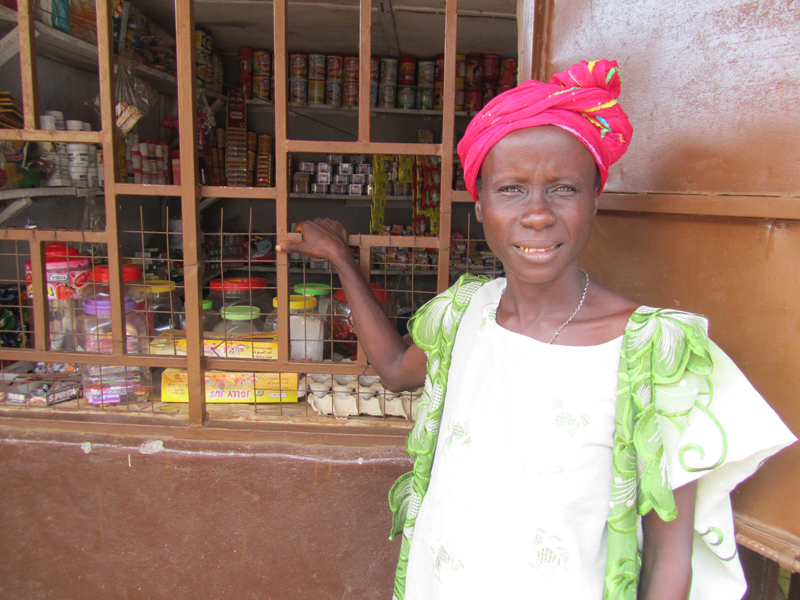
by Eric Rindal – KF15 – Sierra Leone
“What has changed in your business since you took out your loan?” I ask Kiva borrower Fatmata as we stand amongst the whirling crowd in a Freetown market. “Oh, very much, everything has changed,” she says as her eyes quickly sway toward the crowd, then back to mine. I ask her to be more specific; she picks up some of her merchandise and slaps it down with a smile, “I can pay for my child’s school fees.
 I have one, a girl, who is in her last year of schooling.” Her pending graduation is quite an accomplishment in a country where 24% of women are literate and nearly half the population lacks a formal education. When Fatmata mentions her daughter’s final year, it is obvious this is a triumph for her as well.
I have one, a girl, who is in her last year of schooling.” Her pending graduation is quite an accomplishment in a country where 24% of women are literate and nearly half the population lacks a formal education. When Fatmata mentions her daughter’s final year, it is obvious this is a triumph for her as well.
I met with a few more borrowers in Freetown’s market and asked them many of the same questions about their businesses. The sense of achievement was palpable when each of them mentioned their sustained ability to send their children to school or pay for other basic needs. I left the market and silently walked back to my office on Liverpool Street thinking about the borrowers. These loans are about more than straight business.
The externalities of microfinance float through the air like pollen, and, I believe, they will be the catalyst for the next generation to be pollinated and healthfully spur economic progress. The people of Sierra Leone cannot fully expect comprehensive support from their post-conflict government. Instead, they must rely on their own impetus for self-improvement, within their own family and for the nation as a whole. Through their ambition and entrepreneurialism, it appears that a more economically stable life can be obtainable for the children of microfinance borrowers.
Usually my conversations begin with borrowers’ thoughts on the loan and its assistance to their business, but it then quickly melds into thoughts of their family; coloring the conversation with brilliant confidence in their ability to provide a slightly better life for their children. Based on an aggregate of conversations I have had over the last two months with borrowers, I naturally developed basic assumptions where I feel the children of borrowers are major beneficiaries from microfinance. I believe that if a borrower is able to pay school fees without the constant anxiety about family finances, the borrower is less likely to pull that child out of school due to lack of funds or in necessity to help work for the family income. I believe that if borrowers have additional income they will purchase more nutritious, or even more regular, meals for their children. And I believe that more income allows borrowers to prepare for emergencies, such as sicknesses like malaria, typhoid, or dysentery. I like to think these borrowers are seeking familial-interest, rather than self-interest, in hopes of setting a valuable foundation for their children. Familial-interest follows similar tenets of economic self-interest and personal self-improvement in making every effort to actualize their best self; in this case their best family.
Building this tangible and intangible foundation is where many women borrowers in Makeni, Sierra Leone find themselves. I am currently staying in an extra room at the director’s house of Kiva partner Salone Microfinance Trust. With years of development, microfinance, and women’s empowerment experience, Regina knows effective strategies to equip clients. As she and I walked the dirt path to work my first day I asked her how she saw microfinance playing a role in the next generation. She explained how she has seen many women borrowers at SMT begin with a group solidarity loan and after three or four loan cycles, save enough money to buy a small plot of land. From there, the women use the land as collateral for a larger loan, part of which they spend on their business and part they spend on a foundation to a new house. Graduating from a group loan to the larger individual loan, these women partition some of that money to complete their house. This is not a rare occurrence; women are developing their businesses and building their homes. What concrete changes will this make on their children’s wellbeing?

Back to Freetown, in a small store situated deep within a patchwork neighborhood I sat on a three-legged stool as Kiva borrower Hawa sat on her newly acquired kilo of rice.“I bought this with my loan,” she said as she patted her seat; then she clutched my hand, “and you want to see what else?!” We left the store and went up uneven steps, under an askew door frame, and entered a small room just big enough for, “my new deep freezer!” Hawa was on cloud nine through my whole interview, “I have five kids- yes, five- and I can send them all, every one of them, to school.” Before her loan, Hawa struggled to pay for all five of these school fees. Again she grabbed my hand to secure my attention, she waved the other to display the items she purchased with her loan, “Thank you, thank you, tell everyone thank you for the loan.”
So, where will the developing world be in fifteen years when Hawa’s children are adults? My hope is, far ahead of where it is now. I believe microloans lent to borrowers today- yes, that one woman in Sierra Leone or that one man in Ecuador- may determine the lives of their children and the future of the developing world.
PREVIOUS ARTICLE
Update from the Field: Externalities, New Faces + Loans that Change Lives →NEXT ARTICLE
Behind the Scenes: Kiva in the Americas →













